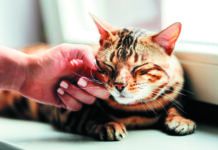Dermatitis and FIV
Q:Are my FIV+ cat’s skin problems caused by the FIV?
I have a nine-year-old male FIV+ cat, who has merged wonderfully with the other three cats in my household. In the June 2015 issue of Catnip, there was a question/answer in the “Dear Doctor” column and one comment caught my eye: “Clinical signs of FIV infection are non-specific … and include [among other things] …. dermatitis.”
I have my boy on an Omega-3 capsule a day and 5 mg Claritin per day. He is almost 14 lbs and the food I provide is a premium brand because one of my other cats is food sensitive. I just brought him to the vet for a therapeutic bath, but he is still scratching/licking/biting himself. He licks until there is a sore in the area.
My veterinarian is hesitant to commit to steroids. Do you have any other suggestions? I was wondering about a “ThunderShirt“.
Having to deal with dermatitis myself, I feel so bad for this sweet boy (and the steroids have never worked well for me, either). Thank you for any help you can provide.
– Barbara Orwig
A: Dear Barbara, In some cats, FIV can suppress the immune system and allow unusual skin infections to develop. Bacterial infections, skin parasites (such as demodex) and ringworm all seem to be more prevalent in FIV positive cats. Alternatively, your cat’s FIV status may be unrelated to his itching, and he may actually have allergic dermatitis (inhalant allergies, food allergy). Rarely, cats can itch because of stress (which the thundershirt might help), but in my experience, cats with “stress itching” are far less common than cats with an identifiable dermatologic issue.
Your doctor is concerned about using corticosteroids to stop the itch. This is a good decision because corticosteroids also suppress the immune system — and if there’s an infection of any type, things could get worse. It is wise to avoid use of corticosteroids in FIV positive cats.
The key to helping your boy is to accurately determine the cause for his itching. If your veterinarian is stumped, you might request referral to a board-certified veterinary dermatologist (visit www.acvd.org). These are veterinarians with specialized training in diagnosing and treating skin disease of animals.
Michael Stone DVM, DACVIM
Clinical Assistant Professor
Cummings School of Veterinary
Medicine at Tufts University
Is This A Case of Feline Acne?
Q:My Persian cat has been unresponsive to treatment for feline acne. What should I do?
My 18-month-old red-and-white Persian developed feline acne on each side of his mouth two months ago and I have been unable to get rid of it. He had one seven-day round of antibiotics, then a steroid shot (even though he has a heart murmur), all while I was dabbing him with hydrogen peroxide twice a day. I even tried putting green clay on his cheeks to dry up the secretions.
Eventually, I started cleaning with salicylic acid and treating with benzoyl peroxide twice a day — all to no avail. Any suggestions? He doesn’t eat out of plastic dishes. Thanks for any help you can give me.
– John Whitaker
A:Dear John, Well, you certainly seem to have covered all of the bases, using systemic antibiotics, topical anti-inflammatories and systemic anti-inflammatories. I would make sure your veterinarian has done skin scrapings to rule out demodectic mange, a fungal culture to rule out ringworm, and a hypoallergenic food trial to rule out food allergy. I have had the best success using 2-percent mupirocin ointment in combination with antibiotics for a four-week duration. Give that a try, if you haven’t already done so.
Frankly, I have a feeling that this is not feline acne. I suspect your cat has idiopathic facial dermatitis of Persian cats, also known as “Dirty Face Syndrome.” It is seen most commonly in young Persians and Himalayans and is thought to have an inherited basis. It is characterized by a dark greasy exudate that adheres to the hairs. The muzzle, around the eyes, and the chin are the most commonly affected areas. Concurrent waxy ears and ear infections are common.
Your cat may have a secondary bacterial infection, although if this were the case, antibiotics would have probably caused some improvement. Your cat could also have a secondary fungal infection caused by Malassezia. Treatment requires anti-fungal medication. Please have your veterinarian check for Malassezia.
If this is ‘Dirty Face Syndrome,’ however, the secondary conditions may be managed well, but the syndrome itself responds poorly to treatment. The most effective treatments for this syndrome are topical anti-seborrhea products, antibiotics or anti-fungal agents (depending on whether there is a secondary bacterial or fungal infection) or oral cyclosporine, an immune-suppressive medication.
Arnold Plotnick, DVM
Catnip contributor
A Change in Fur Color
Q:Why is my cat’s fur color lightening?
Recently, I’ve noticed that our grey DSH cat, Pal, is showing some lightening of his fur. He has been an indoor-outdoor cat his entire life (he’s 15 years old), so while I first thought it was a matter of his becoming sun-bleached, now I’m not so sure. Otherwise, his health and behavior seem exactly the same.
– Debbie Brownstein
A: Dear Debbie, Coat color may slightly change with age. In breeds such as Siamese, Himalayan-Persian, Balinese and Birman, dark hair color is due to temperature-dependent accumulation of pigment in the hair coat (which causes “points” to develop: dark nose, ears, feet, tail). Cats of these lineages — when kept in warm climates — are lighter than those kept in cold climates. Could your cat have an Oriental background, and be spending additional time in warm spots?
Rarely, dogs may present for color coat changes due to hormonal issues, but I’ve never encountered a cat with that issue. If your cat is otherwise happy and healthy, discuss the color change with your veterinarian at Pal’s next examination. I suspect the coat color change may be normal. However, if any signs of illness develop (such as weight change or excessive thirst), an examination should be performed more promptly.
Michael Stone DVM, DACVIM
Clinical Assistant Professor
Cummings School of Veterinary Medicine at Tufts University



